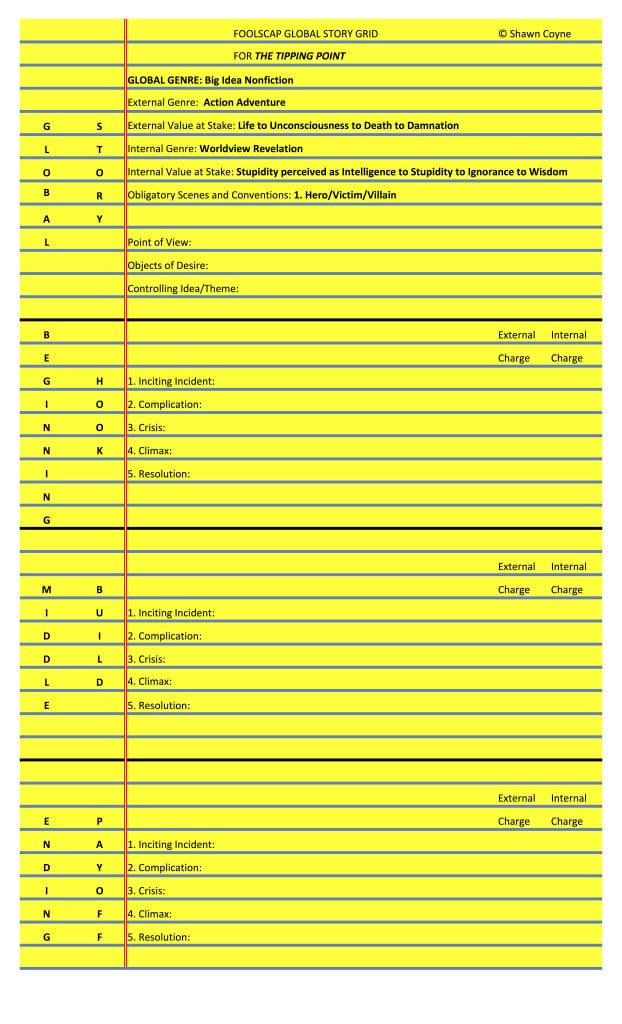From the last post, we’ve sussed out the required hero/s, victim/s, and villain of the Action Adventure Story in The Tipping Point.
These three cast members are indispensable for the Action Genre, a component of the Content leaf on Genre’s Five-Leaf clover. Without having hero/s, victim/s and a villain in The Tipping Point there was no way Gladwell could have written as he describes in his own words, “an intellectual adventure story.”
The heroes of the book are Gladwell and the merry band of experts he consults along the way to make his case. Not just the case for the existence of The Tipping Point as a phenomenon, but of the “How” it actually happens. And wisely, Gladwell brings the reader into the search party, making him/her a hero as well.
The victims of the book are Gladwell, his experts too, and of course the readers of the Story. We have an innate cluelessness about our natural world and that lack of understanding inhibits us from behaving in ways to increase our chances of success. We are globally all “victims” of our environment, what is commonly referred to as the “indifferent universe.”
The villain of The Tipping Point (and again of all Big Idea nonfiction) is what Steven Pressfield calls in his Big Idea book The War of Art “Resistance,” that universal force that crushes our internal quests for meaning. Or in other words, the human condition of being overwhelmed by all of the things that appear to have no answer…of a life spent “not knowing.”
That’s nice to know that The Tipping Point has the cast requirements of an Action Adventure Story, but remember, in order to storygrid the book, we need to:
- Create a Foolscap Global Story Grid
- Create a Story Grid Spreadsheet
- Combine the Foolscap with the Spreadsheet and map out the final Story Grid infographic.
So let’s start filling in our Foolscap Page.
Here’s a generic Foolscap Page that I’ve created for Nonfiction:

Foolscap for Nonfiction
You’ll see that I’ve added a category to our Foolscap page at the very top and I’ve called it the GLOBAL GENRE designation.
I contemplated doing that when I analyzed Thomas Harris’s brilliant The Silence of the Lambs in The Story Grid book, but I decided against it. It was unnecessary because Global Genre in fiction is really just the dominant genre that the writer chooses, i.e. the genre that will be used to create the cover and marketing materials.
The designation of THE GLOBAL GENRE is essentially a reiteration of the DOMINANT CHOICE OF GENRE the writer makes. If the novelist chooses to track movement in both external and internal realms (like The Silence of the Lambs does) then the GLOBAL GENRE would be the one that dominates the Story. So for The Silence of the Lambs, the global genre would be Thriller.
For another novel that tracks both external and internal realms like To Kill a Mockingbird though, the global genre would be Worldview/Maturation. Even though there is a terrific external legal crime story inside of To Kill a Mockingbird, the dominant genre is its internal Maturation plot. That’s one reason why there is no gavel on the cover.
Just to be clear, I would categorize the GLOBAL GENRE of The Silence of the Lambs as THRILLER and the GLOBAL GENRE of To Kill a Mockingbird as WORLDVIEW MATURATION.
Sorry for all of the inside baseball.
Now, back to Nonfiction and The Tipping Point Foolscap Page.
Remember our four big Nonfiction Genre Silos? Academic, How-To, Narrative Nonfiction and Big Idea?
One of these is what we’ll put down for our GLOBAL GENRE for Nonfiction when we’re storygridding a nonfiction book.
The reason why I’ve decided to add the category Global Genre to the Foolscap Page is because I made a mistake in this post, “The Internal Genre of The Tipping Point. I’m flying a little blind here and this is probably the first of many mistakes I’m going to make storygridding The Tipping Point. When I put all of this together in a book “The Story Grid for The Tipping Point,” I’ll make sure it’s crystal clear.
Sorry about that. It’s best to fix it now.
So what was my mistake?
The Tipping Point has both an EXTERNAL and an INTERNAL content genre.
And the INTERNAL GENRE is not ACTION ADVENTURE as I wrote here.
In fact, the INTERNAL GENRE for The Tipping Point is WORLDVIEW REVELATION.
ACTION ADVENTURE is still crucial to Gladwell’s categorization of his book as an Intellectual Adventure Story, though. It’s just that ACTION ADVENTURE is the EXTERNAL GENRE in The Tipping Point, not the Internal.
How did I discover this boner?
Well, I was going to get into the VALUES at stake in The Tipping Point in today’s post. So I began to fill out my Foolscap Global Story Grid for The Tipping Point and I realized that ACTION ADVENTURE is an EXTERNAL CONTENT GENRE, not an INTERNAL GENRE. Check out the Five Leaf Clover Poster again. The Content leaf is divided into External Genres (the dark ones) and Internal Genres (the ones inside the lighter gray portion of the leaf).
I’ll get into what the WORLDVIEW REVELATION Internal Genre is all about in the next post. Here’s the beginning of my Foolscap page to give you some hints about what it will cover.

More to come.
For new subscribers and OCD Story nerds like myself, all of the Storygridding The Tipping Point posts and The Story Grid posts are now in order on the right hand side column of the home page beneath the subscription shout-outs.